Water heating in a private house - an overview of the rules for designing a high-quality boiler-based system
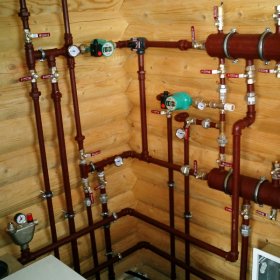
The harsh Russian winter makes everyone think about the warming of their homes. And if the happy owners of centrally heated apartments can shift their concerns to the mighty shoulders of utilities, the residents of the so-called private houses have to solve the problems on their own. There are many heating options. However, among the various heating systems of the home, water heating is most often chosen as the most practical and traditional option.
Content
How is the water heating system arranged?
The principle of functioning of water heating is quite simple. The design is a closed system consisting of a heating boiler, piping and radiators.
The boiler heats the coolant, it can be water or a solution based on one of the glycols, which is piped to radiators located in a heated room. The batteries heat up and give off heat to the air, due to which the room itself is already heated. The cooled coolant returns through the pipes to the boiler, where it is heated again and the cycle repeats.
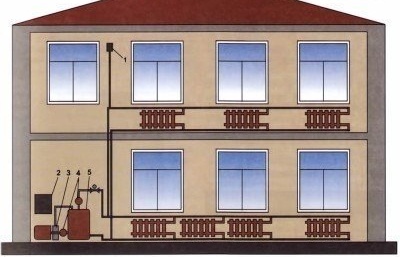
Water heating - a closed system in which the coolant circulates: 1 - expansion tank; 2 — automatic control unit; 3 — vortex generator; 4 - circulation pump; 5 — tank thermos
The circulation of the heat carrier, on which all water heating systems are based, can be carried out in two ways - natural and forced.
Option # 1 - natural or gravitational
The process is carried out due to different densities of cold and hot water. The heated liquid becomes less dense and, accordingly, weighs less, therefore, tends upward, moving through the pipes. When cooling, it condenses, after which it returns to the boiler.
Main advantage natural system autonomy is considered, since it is independent of electricity, and the utmost simplicity of the design. The disadvantages include the need to use a large number of pipes, and their diameter must be large enough to ensure natural circulation. As well as the lack of the ability to use modern battery models with a small cross section and the need for strict adherence to a slope of at least 2 °.
Option # 2 - forced system
The movement of the coolant through the pipes is due to the work circulation pump. Excess liquid generated during heating is discharged into a special expansion tank, most often closed, which prevents the evaporation of water from the system. If a glycol solution is selected as the heat carrier, the expansion tank must be closed without fail. In addition, there is a pressure gauge in the system that monitors pressure.
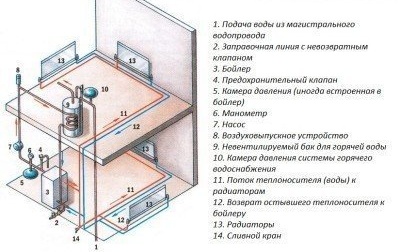
The forced system implies additional costs for the expansion tank, pressure gauge, pump, temperature regulators, etc.
The design advantages are undeniable: a small volume of coolant, which can be used not only water, lower consumption of pipes, the diameter of which is smaller than in the previous case. The ability to control the heating temperature of radiators, batteries can be of any type with any pipe diameter. The main disadvantage is the dependence on the supply of electricity, through which the pump works.
A more detailed comparison of these two options can be seen in this video:
An overview of the forced circulation system and a detailed description of the principle of work are presented in our article:https://aquatech.tomathouse.com/en/otoplenie/razvodka-otopitelnoj-sistemy/sistema-s-prinuditelnoj-cirkulyaciej.html.
Devices required for system operation
A home water heating system will function smoothly only if its main components are correctly selected.
Boiler for heating the coolant
Practice shows that it can be of any type: gas, electric, liquid or solid fuel. The most economical models that run on gas. However, they require a gas main, regular monitoring and maintenance by specialists. Solid or liquid fuel implies complete independence of heating from centralized networks, but it will require the arrangement of a special storage for fuel reserves.

The boiler is most often installed either in the basement of the house, or in a specially equipped room - a boiler room
The electric boiler must be connected to the network and consumes a fairly large amount of energy. This option is generally of little use, since it is easier to put electric radiators and directly convert electricity into heat.
The power of the equipment is selected based on the area of the heated room. On average, to equip water heating at home, a boiler is selected with a capacity of 1 kW per 10 square meters. meters with a wall height of not more than 3 m. It is also worth considering the degree of insulation of the home, the size of the windows and the presence of possible additional heat consumers.
Pipes making up the heating circuit
Traditionally, they were made of metal. But steel structures mounted by welding are easily corroded. Therefore, they were replaced by galvanized and stainless pipes, in which this lack is absent. The most reliable version of the metal - copper pipes that withstand changes in pressure, temperature and are not susceptible to corrosion. They can simply be "hidden" in the walls of the house. However, the high cost of such equipment makes it one of the exclusive options.
Plastic pipes have good performance. They are durable, not susceptible to corrosion, easy to install, no precipitation is deposited on their internal surfaces. The only drawback: a high coefficient of thermal expansion, which provokes damage to the pipe during temperature extremes.
Analysis of classic wiring options
It should be noted that water country house heating can be equipped in many ways. Distinguish single-circuit and dual-circuit system. The first is intended exclusively for space heating.
It consists of a single-circuit boiler with atmospheric exhaust, a simple single-pipe wiring and the required number of radiators. In order to provide hot water, two such structures can be installed simultaneously.In this case, one will carry out heating, and the second - to heat water. Which is quite practical, since in the warmer months you can only use water heating.
The design is considered the most inexpensive and easiest to install, best suited for homes whose area is less than or equal to 100 square meters. m. This is probably why it is often used to equip water heating in the country. It can be improved by adding a circulation pump, two-pipe wiring and temperature regulators on radiators.
The double-circuit design is used for heating and hot water supply. It is especially convenient in houses where no more than 4 people live. Another nuance: the water must be tap water or specially softened, hard water directly from the well will not work.
Based on the principle of movement of the coolant, the system can be one-pipe, two-pipe and collector. Let's consider each of them in more detail.
Option # 1 - Monotube System
The coolant moves sequentially from the first battery to the next. In this case, the temperature of each subsequent radiator will be slightly lower. The very last one may already not have enough heat for sufficient heating of the room.
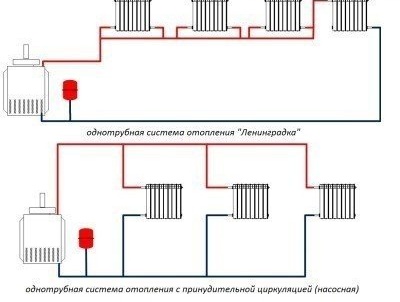
The one-pipe system is practically unregulated, since a blocked battery will block the access of fluid to all others
If necessary, the radiator must be repaired and the coolant will have to be drained from the system, and only then can the device be manipulated.
Option # 2 - two-pipe system
This scheme warms up the room with better quality. It assumes the presence of two tubes suitable for each battery. In one of them, a heated liquid enters the radiator, and with the help of another it is discharged after cooling.
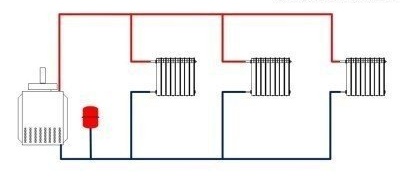
A distinctive feature of such a system: pipes with a hot coolant are connected to the radiators in parallel, which makes it possible to disconnect the batteries if necessary
In more detail about the device and the principle of operation of a two-pipe heating system, you can from our article:https://aquatech.tomathouse.com/en/otoplenie/razvodka-otopitelnoj-sistemy/dvuxtrubnaya-sistema-otopleniya-chastnogo-doma.html
As in the previous version, in the last radiator the temperature will be slightly lower, but the losses in this case are insignificant.
Option # 3 - Collector Wiring
The most convenient system to use, which assumes the presence of a collector, from which a pipe with hot coolant fits separately to each of the radiators and another returns the cooled liquid. It makes it possible to regulate the temperature in the room, to repair or replace any part of the system without first turning off the heating. The main disadvantage: high consumption of pipes and the need to install a manifold cabinet.
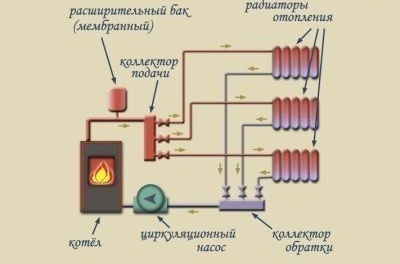
The collector system allows you to adjust the temperature in the room and repair radiators without turning off the heating
If desired, it is quite possible to equip home water heating with your own hands. The design of the system will require accurate calculations and competent selection of equipment, which subsequently will need to be mounted qualitatively. If there is doubt in your own strengths, it is better to entrust the responsible business to specialists who professionally and in a short time will perform all necessary work. Their result will be a warm and comfortable home.
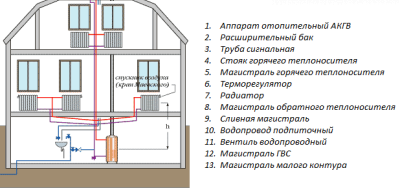
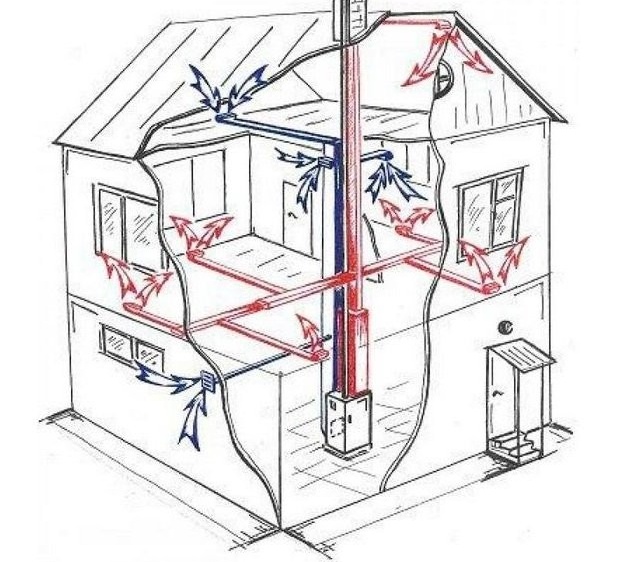
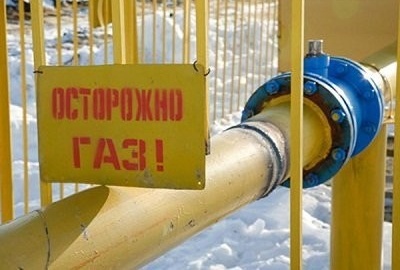
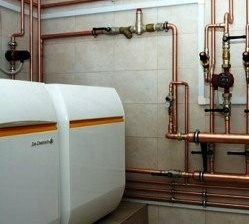
1 comment